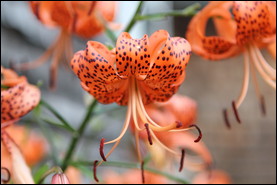 These beautiful tiger lilies will bloom each year in a well-tended garden. |
Why are they called perennials? Because they come back each year. And they bring memories of the folks who gave them to us. Somehow flowers cheer us. The colors. The fleeting beauty. The passage of time. And the memories.
Part of the reason my column and my website is named "MothersGarden" is because I have flowers from my mother’s garden or from other family and friends. And I have passed them on to my daughter.
The flowers come back in a succession of bloom and one remembers with pleasure the friends and family members they came from. Each week is different and each year a surprise. A colorful minuet of flowers, unfolding, leaping like a corps de ballet across the stage we call our garden.
It begins in spring with flowering bulbs, then violets, bleeding heart, perennial alyssum, ajuga. Next, about a month after, come the peonies, iris, coral bells, columbine. In summer, daylilies and phlox and pereskia appear. August slows down but sedum, asters and chrysanthemums soon arrive. Most important is to get survivors, plants that have reappeared year after year in other gardens. Survivor genetic stock.
But perennials have some dirty little secrets, which I share here:
1. Most bloom well for only 2 or 3 weeks and many die after a few years. One has to plan for a seasonal succession of bloom. To have a really wonderful garden also plant some annuals fill in the bare spots like cosmos, cleome and petunias.
2. Some perennials grow better than others. Most of the ones I carefully planted several years ago in a special bed by my window have disappeared. A brilliant young scientist who was also a great gardener explained it this way. After 1 year, 1/3 will die, 1/3 will live and 1/3 you won’t like. Survival depends on good genetic stock.
3. Fertilizer helps a lot, though I have not yet figured out which is best and most efficient. One successful friend sprinkles bulb fertilizer in spring and again in fall "because it’s easier." Watering with Peters 20-20-20 makes everything set flower buds like mad. Great on annuals, but or perennials, only until end of June. (New growth winter-kills.) There are many organic fertilizers that promote healthy growth, but sometimes not enough flower buds. (Add a little potash enhance flowering.)
Fertilizing is actually a very exacting science. However, famous gardener, Gertrude Jeckyl, who introduced perennial gardens, had her gardener bury a dead rabbit under each new lily to fertilize it.
 Fertilizing perennials can be a very inexact science. |
4. Weeds grow better than perennials. So does grass, ivy, myrtle, poison ivy, etc. so carry a paper bag when you walk around outside to pull and throw them in. Gertrude Jeckyl also always carries her secateurs (pruning shears) to clear unwanted intruders.
5. Many will self-seed. Perennial and biennial favorites we love survive by re-seeding. Columbine, campanula, phlox, mallow, iberis, violets, bleeding heart among others. One can help by planting ripe seedheads under the plants to keep them coming,
6. Division. Many varieties are easy to propagate by splitting off and planting the young little vigorous shoots that grow at the outside edges of old clumps. Spread in early spring or late August. This works well for chrysanthemums, phlox, oenathera, coreopsis, ladies mantle, daylilies, iris, lily of the valley and ajuga. It takes at least a year or two until they reach a good size.
7. Good old fashioned perennials from local gardeners provide the best genetic stock. These survivors are not available at the supermarket or chain stores or on the web. They are best bought at local nurseries or, if you are lucky at a garden club sale.
Ruth S. Foster is a landscape consultant and arborist. More gardening information can be found on her website: www.mothersgarden.net.
Credit: www.mothersgarden.net




























